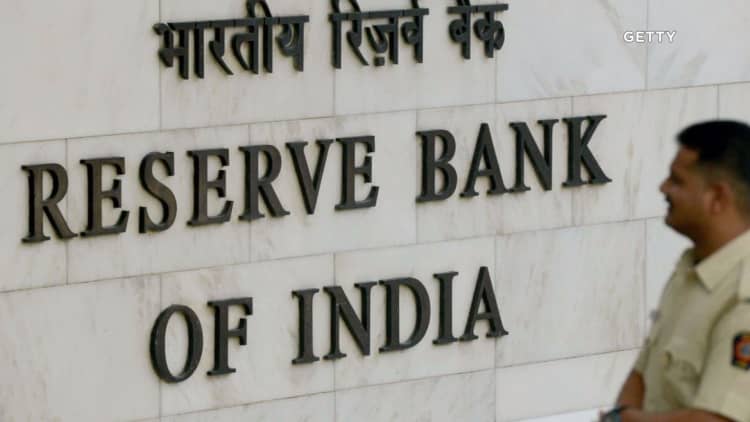Banks are among the hottest stocks as investors try to make sense of the recent stock market swoon and rising interest-rate environment. But it's not only U.S. stocks that are attracting the attention of high-profile investors. Value legend Bill Nygren's Oakmark Funds have become the latest addition to the growing list of billion-dollar-plus fund managers snapping up stocks of India's private banks, one of the biggest beneficiaries of a resurgent and reforming South Asian nation's burgeoning middle-class-driven, high-single-digit GDP growth story.
In a note to investors, Oakmark Funds' recently shared that for the first time its Global Fund started buying an India-based stock, Axis Bank, a private bank, at the end of 2017.
"Axis is the Fund's first holding ever to be domiciled in India," Oakmark Global said in the note. "We believe the country's strong economic growth, coupled with low financial penetration, should result in attractive long-term growth rates for the Indian banking sector."
Indian private banks also is a sector that the funds run by billionaire Ron Baron have been adding. Baron's emerging markets team said at his annual investment conference in November that while China was the hotter market sooner in the emerging markets boom, India is the better emerging markets bet for the longer term.
India is set to reclaim the title of the world's fastest-growing economy this year, leapfrogging China. The World Bank projects India's GDP to grow at 7.3 percent in 2018 and 7.5 percent in 2019.
The Oakmark International Fund (OAKIK) also owns Axis Bank, the third-largest private-sector bank in India in terms of assets and deposits. Axis ranks among the top 25 holdings in each of these portfolios, making up 1.55 percent of the portfolio weight.
Nygren himself isn't a portfolio manager on these funds. The chief investment office for international equities at Oakmark is David Herro.
Oakmark International has an enviable success record
The Oakmark International Fund is one of the few actively managed mutual funds that has been able to keep up with Vanguard index funds in the race for assets. Last year Oakmark International was among the top 10 funds for new flows — 6 of the top 10 were Vanguard funds. The $43 billion Oakmark International Fund took in near-$10 billion in assets in 2017. The reason for its success in an era of index fund dominance is simple: It is the No. 1 ranked fund by performance in its foreign stock category over the past 10-year and 15-year periods, according to Morningstar.
"Private-sector banks are well positioned to benefit from this growth," wrote the Oakmark managers in the note, making a clear distinction between faster-growing and better-managed private banks and highly leveraged, poorly managed and technologically outmoded, state-owned public banks. "India's public-sector banks face considerable obstacles, including bureaucratic priorities, low capital levels and meager investments in technology."
While the public-sector banks in India currently hold 70 percent market share, Oakmark expects "the private banks' recent share gains to accelerate in the years to come."
Although smaller than private peers HDFC Bank and ICICI Bank, Axis, with "its diversified business (45 percent retail, 40 percent corporate, 15 percent small- and medium-sized enterprises) and strong distribution platform," is well positioned to grow its business by capitalizing on its recent infrastructure spending, he noted.
Baron's Emerging Markets Fund (BEXFX) started buying HDFC Bank in March 2017. The middle of last year saw an increasing number of big mutual funds make bets on India's private banks, including the Goldman Sachs Emerging Markets Equity Fund (GIRMX), Morgan Stanley International Opportunity Fund (MIOLX) and the T. Rowe Price Global Growth Fund (RPGEX) — which has a longer history than most buying Indian bank stocks. Baron has 1.39 percent of its portfolio in HDFC and an additional 1.19 percent in another private player, Kotak Mahindra Bank.
More from Global Investing Hot Spots:
North Korea's surprising entrepreneurial boom
China, Russia vie to beat US with major Arctic investments
Buffett, already a 'god of stocks' in China, may need to leave bigger mark
Since assuming office in 2014, Indian Prime Minister Narendra Modi has made sweeping changes, including digitization, tax reforms and ease of doing business, to make India more attractive to foreign investors and businesses. A slew of measures have been taken to bolster India's banking sector, too. Capital infusion, tech innovation, biometric identity card and, arguably the biggest of them all, Pradhan Mantri Jan–Dhan Yojana (meaning Prime Minister's People's Wealth Scheme), a financial inclusion program that has so far brought more than 300 million unbanked people, and account deposits worth $10 billion, into the fold of India's formal banking system as of October 2017, according to local media reports.
These positive structural changes, which led Moody's to upgrade India's credit rating last November, appear even more attractive against the backdrop of India's fast-growing economy. The Indian government claims the country's economy is set to become the fastest-growing major economy, bouncing back from last year's demonetization and , events that proved to be detrimental to the nation's economy.
The Indian stock market has been booming overall.
While much of these reforms are aimed at India's public banking sector blighted by bad loans, outmoded technology and poor management, they will have a knock-on effect on the private banking sector as rapid urbanization causes large populations to move from state-owned banks in rural areas to more modern, private banks in urban India. In a stark contrast to their public peers, India's private lenders are run efficiently, are quick to adopt the newest banking technologies and contemporary practices and are well positioned to benefit from the tailwind created by urbanization and growth in middle class and their disposable incomes.
Private banks have been able to consistently chip away at credit costs and improve their bottom line by setting aside capital for provisioning, following conservative business practices and getting higher-yielding loans.
"The company's profitability should also improve meaningfully once credit costs normalize, and its excellent deposit franchise and relatively strong balance sheet should help fund growth while protecting against any unforeseen asset-quality issues," Oakmark's team wrote. The decision to invest in Axis Bank, came as it was trading "at a meaningful discount to our estimated intrinsic value, and we are taking advantage of its short-term price weakness to initiate a position," Oakmark stated in December.
The multiyear sour loan crisis has hurt the share prices of India's banking sector at large and state-run banks in particular. While private banks have felt the ripple effects of the negative headlines, they proved to be more resilient. The Nifty Private Bank index has grown more than 20 percent on a year-over-year basis. By contrast, the Nifty PSU Bank index has lost more than 5 percent in the past year, as of Feb. 20, 2018.

Leading public-sector banks are no match for the leading private lenders whose stock prices have doubled over the past two years. Stocks of HDFC, ICICI, Kotak Mahindra, Axis Bank, Yes Bank have seen close to or more than 100 percent growth, while the stock of Edelweiss Financial Services has more than quintupled in price. Most of the leading state-run banks are trading far below their 2017 peaks.
Structural deficiencies that plague the public banking sector in India have created an environment where there is neither accountability nor incentive or pressure for profitability. This makes them vulnerable to be manipulated by those with political clout and, therefore, susceptible to fraud.
Apart from structural tailwind, there are cyclical forces that are propelling Indian banks to greater profitability. Therein lies their long-term growth story for Sammy Simnegar, portfolio manager of Fidelity Emerging Markets Fund, which invests 1.24 percent of its portfolio in HDFC Bank. "As the Indian government has encouraged and will continue to encourage housing, this might be a multiyear story," he said. "When you build more homes, you're going to need to finance those homes."
The positive trend is further supported by the ongoing digitization and financial inclusion of Indians, which have boosted peoples' creditworthiness. "Now that all these people have digital IDs and bank accounts, formalizing the economy, savings rates go up and individuals are able to borrow money to invest and buy homes because they're now part of a formal banking system."
As an island of steady economic growth in a world of more fragile recovery, India is getting increasingly noticed by the global investment community.
Further, events like the recent global equities rout, which happened particularly precipitously in North America, are making the need for portfolio diversification more compelling for equities investors and portfolio managers.
The timing and tactical significance of seasoned fund firms like those run by Nygren and Baron buying Indian banks is evidence that there is a good reason for investors to look farther afield at geographies and sectors that are kept buoyed by robust fundamentals and economic tailwind.
For now at least, Indian private banks seem to fit the bill for a growing number of fund managers who have taken sizeable positions in private banks in India in their global and emerging market funds.
Growing interest in India's private banks
| Fund | Bank | % of portfolio | First bought |
|---|---|---|---|
| Oakmark International | Axis Bank | 1.55 | December 2017 |
| Baron Emerging Markets Fund | HDFC Bank | 1.39 | March 2017 |
| Baron Emerging Markets Fund | Kotak Mahindra Bank | 1.19 | June 2016 |
| T. Rowe Price Global Growth Stock Fund | Yes Bank | 1.15 | March 2017 |
| T. Rowe Price Global Growth Stock Fund | Kotak Mahindra Bank | 1.15 | March 2012 |
| T. Rowe Price Global Growth Stock Fund | HDFC Bank | 1.15 | March 2011 |
| Goldman Sachs Emerging Markets Equity Fund | Edelweiss Financial | 0.84 | March 2017 |
| Morgan Stanley International Opportunity Portfolio | HDFC Bank | 3.05 | March 2017 |
Source: Morningstar
—Vikram Barhat, special to CNBC.com
Correction: This story has been updated to attribute recent portfolio commentary to the international equities team at Oakmark Funds led by chief investment officer David Herro.





